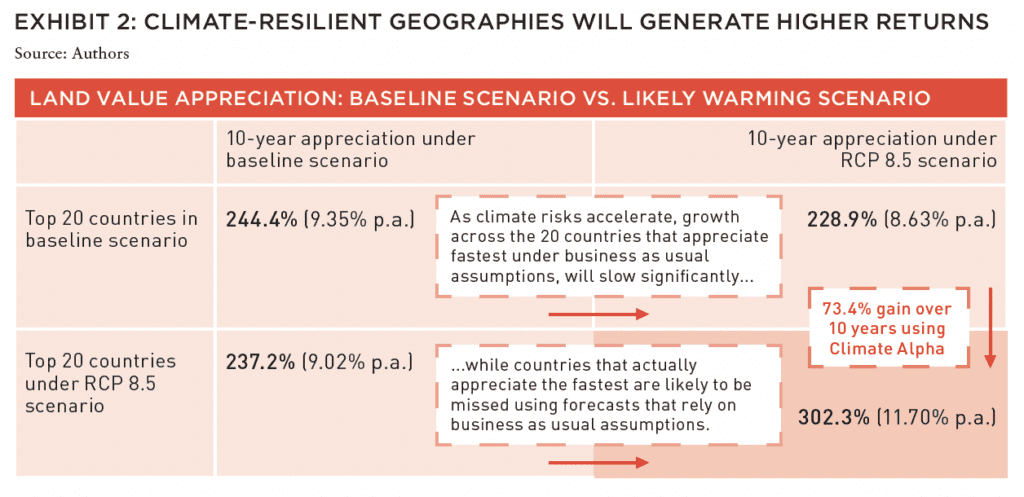Investors have plenty of reasons to be worried about climate risk, but there are already winners in the new climate economy—and there will be more.
Investors of the new climate economy have plenty of reasons to be worried about climate risk, including the physical damage from extreme weather events and their impact on asset valuations and insurance premiums; chronic issues of water stress and drought; and more stringent regulatory requirements and ESG pressures from shareholders and stakeholders alike.1
But there will be—and already are—winners in the new climate economy. Real estate investors should take note of the many ways in which the climate theme impacts their core business but also creates new adjacent opportunities to capitalize on the volatility that lies ahead.
First, at the highest level, it’s important to appreciate that climate has taken its place alongside fiscal and monetary policy, demographics, geopolitics, and technology as a macro and systemic thematic driver of not just the economy but civilization itself. SwissRe estimates that global GDP could drop 18% by 2050 if climate change continues unabated.2 (By comparison, the COVID pandemic slashed only 3.4% from world GDP in 2020.3) The world’s largest asset class by far—land and real estate—may well suffer the most.
Climate change could fuel mass migrations totaling over one billion people,4 accelerate state failure from Central America to Africa to West Asia, and exacerbate conflict over precious freshwater and other resources.5 At its root, all finance will become spatial finance in which earth observation and geospatial data are causally linked to economic outcomes.
PRICING CLIMATE RISK
What climate as a macro theme has in common with other drivers is that it should be priced into investment strategies of any duration, intersects with other drivers in complex ways, and creates both enormous risks as well as major new opportunities.
The first domain of opportunity is geographic. Countries that manage to remain climate resilient, politically stable, and offer open markets are likely to become more attractive destinations for global savings to be invested in real estate and other assets. For example, despite the wildfires currently raging Canada in 2023, the country still attracted nearly one million new permanent migrants every single year, with property prices appreciating nationwide.6
In industry jargon, “opportunistic” implies risky investments, yet the overlay of climate modeling, fiscal allocation, demographic movements, and other trends can provide high conviction around locations that will relatively outperform. The new opportunity, then, lies in such antifragile regions better adapted to climate stress. These locations, which span parts of North America such as the Great Lakes to much of central Europe, Central Asia, Southeast Asia, and Japan, are among the locations we describe as “climate oases” that will appreciate in the future. More broadly, a broad zone referred to as the “New North” is likely to absorb a growing share of global savings and capital as it attracts migrants and investment.7
LEADING ADAPTATION

At the intersection of climate change, migration, and sustainable real estate lies an important opportunity for the industry to lead our adaptation efforts. According to UN Habitat, at least three billion people will require better housing by the end of this decade, which means that 96,000 new homes need to be built each day between now and then.8
Eventually, rather than building these habitats where people are, we will need to start moving certain populations to geographies less damaged by climate change, at lower risk of future effects, and with better resources and technology. Rising fire and flood insurance premiums, as well as chronic droughts and heatwaves, make this all but inevitable.
Our own Climate Alpha research suggests that investing early in climate-resilient geographies will generate more than 70% higher returns on real estate portfolios by 2030 alone. Property developers, asset managers, and insurers should take heed, accelerating the acquisition of land, construction of affordable housing, and adjustment of premiums to anticipate, encourage, and profit from climate-induced migrations. New technologies should help us to do this with speed. Consider the US-based company Alquist, which can now print a three-bedroom home in just over 24 hours, versus the typical four weeks that the volunteer-powered nonprofit Habitat for Humanity takes to construct one.
The second arena of opportunity lies in the transformation of industrial systems. A narrow focus on energy production alone killed the first clean-tech wave of the late 2000s. Today’s movement is far broader. Whether due to scarcity or regulation, there is a rising premium for the sustainable production and utilization of energy, water, food, fiber, and materials—and the transportation networks and supply chains that enable their mobility. This of course applies to the digital economy of data centers as well, underscoring how no aspect of the twenty-first century global economy can ignore the influence of climate factors, both as cause and effect.
The quest for “circular” or full lifecycle endogeneity and accounting is generating new business models in countries rich and poor, reshaping global trade flows with an emphasis on more localized systems. European mandates such as Article 8 and 9 sustainability themed funds will further create opportunities to invest into the climate adaptation thesis.
This trend is being actively reinforced by the new wave of industrial policies sweeping the West. Whereas government support for critical sectors has been common in Europe, the US’s simultaneous Inflation Reduction Act (IRA), Bipartisan Infrastructure Bill, and CHIPS Act are collectively stimulating an industrial renaissance whose geography will boost economic multiplier effects across the country. Importantly, investors should not only track this growing corporate investment footprint—which amounts to nearly $1 trillion between 2021–2022—but also whether or not the locations receiving investment exhibit climate resilience and adaptation to ensure their continued desirability. Similar trends are underway with Europe’s Green Deal, and China and Japan’s industrial policies and R&D in battery and materials technologies.
CLIMATE TECHNOLOGIES

Climate tech has thus emerged as an asset class unto itself due to the enormous investment driven by venture capital and institutional investors.9 Global capital markets from pensions and sovereign wealth funds to banks and family offices are now chasing climate tech deals at all stages from seed to IPO. This will lead to entirely new platforms of investable assets, driving asset allocation and capital deployment in innovative ways that all have very strong implications for the built environment, whether greening buildings or fortifying electricity grids and building more efficient primary and secondary supply chains.
The laws of physics may determine the fate of humanity more than the geopolitical balance of power. But already AI is making a case as a third force alongside and conditioning these two. Though the current vogue is to posit AI as a singular battlefield for supremacy, in fact it is a rapidly democratizing suite of technologies that can help any society—or collection of them—to anticipate, model, and steer individual, company, market, economy, and government behavior to adapt to the climate challenge. Simulations of rising sea levels, floods, droughts, and heatwaves enable the public and private sectors alike to avoid making unnecessary investments in what are likely to be stranded assets, energy grids to balance supply and demand loads, and both active and passive investment strategies to build portfolios favoring firms with less climate risk and higher resilience to climate shocks.
Such scenario planning has been officially mandated by the US Federal Reserve, which this year required major banks to model climate risks and the impact on their portfolios, both to their physical assets as well as in their underwriting. Understanding how a singular event—such as a Category 5 hurricane landfall in lower Manhattan—might unfold in terms of immediate damage to infrastructure and real estate, followed by longer-term outward migration and declines in both economic growth and tax revenues, requires forecasting capabilities that integrate both climate and socio-economic variables.
As we watch the frequency and severity of climate disruptions mount in real time, investors and regulators need to pay much greater attention to how such toolkits can model complexity and deliver insight for their investment decision-making.
ADDRESSING THE FUTURE
Addressing climate change requires both mitigation and adaptation, and we believe the latter represents an even better business opportunity. As we learned from Charles Darwin, those who adapt are the most likely to survive and thrive. Small investments result in significant preparation for an unpredictable future.
Sooner rather than later, as with other macro-drivers, climate-themed investing will not be distinct from other forms of investment. Climate investing will simply be . . . investing.
In other words: climate risk is here, and climate opportunity awaits.
IN THIS ISSUE

NOTE FROM THE EDITOR: WELCOME TO #13
Benjamin van Loon | AFIRE
OFFICE TROUBLES: FINANCIAL RISKS AND INVESTING OPPORTUNITIES IN US CRE
Dr Alexis Crow | PwC + Byron Carlock
THE UNDERPERFORMANCE PARADOX: WHY INDIVIDUAL INVESTORS FALL BEHIND DESPITE BUYING LOW
Ron Bekkerman | Cherre + Donal Ward | Tenney 101
CLIMATE THREAT: EXTREME WEATHER IS THE NEW NORMAL FOR REAL ESTATE
Jacques Gordon, PhD | MIT
CLIMATE OPPORTUNITY AWAITS: HOW REAL ESTATE CAN INVEST IN CLIMATE ADAPTATION
Michael Ferrari, PhD and Parag Khanna, PhD | Climate Alpha
PREMIUM PRICE TAGS: INSURABILITY THROUGH PROPERTY RESILIENCE DATA
Bob Geiger | Partner Engineering & Science
REAL ESTATE WEB3: THE EMPEROR’S NEW CLOTHES OR THE NEXT BIG THING?
Zhengzheng Tan, Alice Guo, and Naveem Arunachalam | MIT
ADAPTIVE TO REUSE: COULD BUILDING CONVERSIONS BE DIFFICULT, EXPENSIVE . . . AND STILL PROFITABLE?
Josh Benaim | Aria
RENOVATE, REBRAND, REPOSITION: ADDING VALUE TO MULTIFAMILY THROUGH REVITALIZATION
Robert Kilroy, CFA | The Dermot Company + Will McIntosh, PhD | Affinius Capital
REDEFINING THE PROGRAM: A CONVERSATION WITH ARCHITECT DAVID THEODORE
Peter Grey-Wolf | Wealthcap + David Theodore | McGill University
SENIOR HOUSING UPDATE: EMERGING OPPORTUNITIES THROUGH DEMOGRAPHIC TAILWINDS AND DIMINISHING SUPPLY OUTLOOK
Robb Chapin, Jack Robinson, Andrew Ahmadi, and Morgan Zollinger | Bridge Investment Group
SENIOR HOUSING UPDATE: UNPRECEDENTED DEMOGRAPHIC ACCELERATION MAY DRIVE STRONG OPERATING FUNDAMENTALS AMID ECONOMIC SLOWDOWN
Tom Errath | Harrison Street
HOLIDAY FROM HISTORY: REASONS FOR US OPTIMISM IN A CHANGING GLOBAL ENVIRONMENT
Charlie Smith | Newmark
CRADLE TO CRADLE: AN ALLOCATOR’S VIEW ON IMPLEMENTING ESG INITIATIVES
Christopher Muoio and Katie Cappola | Madison International Realty
FREE LUNCH: MULTI-DIMENSIONAL DIVERSIFICATION IS A FULL-COURSE FREE MEAL
Elchanan Rosenheim and Tali Hadari | Profimex
CAMPAIGN MESSAGING: CFIUS, AFIDA, AND EXPANDING FEDERAL AND STATE RESTRICTIONS ON FOREIGN INVESTMENT IN US REAL ESTATE
Caren Street, John Thoms, and Anya Ram | Squire Patton Boggs

—
ABOUT THE AUTHORS
Dr. Michael Ferrari is chief scientific and chief investment officer at Climate Alpha, an AI-powered software platform dedicated to future proofing global investment. Dr. Parag Khanna is Climate Alpha’s founder and CEO. He is also author of MOVE: Where People are Going for a Better Future (2021).
—
NOTES
1. https://climatealpha.ai/top-5-reasons-you-should-consider-climate-risk/
2. https://www.swissre.com/media/press-release/nr-20210422-economics-of-climate-change-risks.html
3. https://www.statista.com/topics/6139/covid-19-impact-on-the-global-economy/#topicOverview
4. https://www.nytimes.com/interactive/2020/07/23/magazine/climate-migration.html
5. https://www.nytimes.com/2022/03/18/climate/climate-armed-conflict-water.html
6. https://www.cbc.ca/news/canada/canada-record-population-growth-migration-1.6787428#:~:text=Canada-,Canada’s%20population%20grew%20by%20record%201%20million%20in%202022%2C%20spurred,Statistics%20Canada%20said%20on%20Wednesday.
7. https://www.reuters.com/article/idUS141436308520130806
8. https://unhabitat.org/topic/housing
9. https://www.bloomberg.com/graphics/2023-climate-tech-startups-where-to-invest/?sref=wAVxlDts
—
THIS ISSUE OF SUMMIT JOURNAL IS PROUDLY UNDERWRITTEN BY

For more than 20 years, Yardi has developed real estate investment management software that helps managers of global assets valued at trillions of dollars make informed investment decisions. Yardi Investment Suite clients include many of the world’s premier investment management funds, start-ups and partnerships of all types and sizes.
Real estate investments grow on Yardi. That’s because the Yardi Investment Suite automates complex investment management processes and provides full transparency, from the investor to the asset. Through interactive dashboards, investors can view documents and have access to reports and metrics. Collaboration is easy when your advisor or accountant is given access to view your accounts, reducing the need for emailing sensitive information.
The Yardi Investment Suite leads the real estate industry through innovation and value with fully integrated investment management, property management and accounting functionality. Fund managers and their customers can manage assets with superior efficiency and ease. Learn more.

